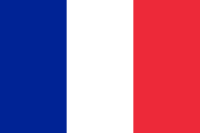The French flag, known also as the tricolore, is divided vertically into three equal-sized blocks of colour. From left to right, the colours are blue, white, and red.
History of the French Flag
The French flag as we know it was first introduced during the French Revolution in 1794, although it did first appear in 1790 with the colours in reverse order.
Blue and red are the traditional colours of Paris, whose flag can be seen to the right. Lafayette (leader of the garde nationale during the French Revolution) argued for the white band, symbolising royal authority, to be added between the blue and red stripes to "nationalise" the flag.
Variations on the national flag of France
The French navy use a variation of the national flag in which the red panel is slightly wider than the blue and white ones. This is because of the 'rippling' or 'flapping' effect that occurs when the flag is raised, which makes the furthest panel appear smaller. If the red panel is made larger than the others, then it will appear to be in proportion when flown.
History of the French Flag
The French flag as we know it was first introduced during the French Revolution in 1794, although it did first appear in 1790 with the colours in reverse order.
Blue and red are the traditional colours of Paris, whose flag can be seen to the right. Lafayette (leader of the garde nationale during the French Revolution) argued for the white band, symbolising royal authority, to be added between the blue and red stripes to "nationalise" the flag.
Variations on the national flag of France
The French navy use a variation of the national flag in which the red panel is slightly wider than the blue and white ones. This is because of the 'rippling' or 'flapping' effect that occurs when the flag is raised, which makes the furthest panel appear smaller. If the red panel is made larger than the others, then it will appear to be in proportion when flown.
